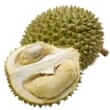Background
- Durian refers to the fruit of the trees of the genus Durio. There are at least 30 recognized Durio species and at least nine edible species. Durio zibethinus is the most common of the Durio species. Durio species are native to wet equatorial forests in Southeast Asia.
- According to traditional use, durian may have antibacterial, anti-inflammatory, and vasoconstrictor properties. According to laboratory analysis, durian has antioxidant activity and may reduce cholesterol levels in animals.
- Traditionally, durian leaves and roots are in Malaysia used to treat fever. The juice of fresh leaves is used as an ingredient in a lotion for fevers, and the juice from the bark is used as an antimalarial in Sumatra. The Javanese also believe that durian has aphrodisiac properties. In addition, durian leaves are considered anthelmintic and are used for jaundice treatment. Decoctions of the leaves and fruits are used to treat swelling and skin conditions.
- Durian is commonly known as the "king of the fruits," a label that may be attributed to its formidable appearance and strong odor. Durian fruit is used to flavor a wide variety of sweet edibles, such as traditional Malay candy, "ice kachang," rose biscuits, cakes, and ice creams. There are also a variety of dishes served with durian, such as pulut durian (rice steamed with coconut milk and served with ripe durian) and tempoyak (fermented durian that may be eaten either raw or cooked with rice or used for making curry). Durian seeds may be eaten when they are boiled, roasted, or fried in coconut oil. Eating raw durian seeds is not advised, due to possible toxicity.
References
- Berry, S. K. Cycloproprene fatty acid in some Malaysian edible seeds and nuts. I Durian (Durio zibethinus, Murr.). Lipids. 1981;15:452.
- Charoenvai S, Khedari J, Hirunlabh J. Heat and Moisture Transport in Durian Fiber Based Lightweight Construction Materials. Solar Energy 2005;8(4):543-554.
- Haruenkit R, Poovarodom S, Leontowicz H, et al. Comparative study of health properties and nutritional value of durian, mangosteen, and snake fruit: experiments in vitro and in vivo. J Agric Food Chem 2007;55(14):5842-5849. View Abstract
- Khedari, J., Charoenvai, S., and Hirunlabh, J. New Insulating Particleboards from Durian Peel and Coconut Coir. Building and Environment 2003;435-441.
- Khedari, J., Nankongnab, N., Hirunlabh, J., and Teekasap, S. New Low-Cost Insulation Particleboards from Mixture of Durian Peel and Coconut Coir. Building and Environment 2004;39(1):59-65.
- Leisner JJ, Vancanneyt M, Rusul G, et al. Identification of lactic acid bacteria constituting the predominating microflora in an acid-fermented condiment (tempoyak) popular in Malaysia. Int J Food Microbiol 2001;63(1-2):149-157. View Abstract
- Leisner JJ, Vancanneyt M, Van der Meulen R, et al. Leuconostoc durionis sp. nov., a heterofermenter with no detectable gas production from glucose. Int J Syst Evol Microbiol 2005;55(Pt 3):1267-1270. View Abstract
- Leontowicz H, Leontowicz M, Haruenkit R, et al. Durian (Durio zibethinus Murr.) cultivars as nutritional supplementation to rat's diets. Food Chem Toxicol 2008;46(2):581-589. View Abstract
- Leontowicz M, Leontowicz H, Jastrzebski Z, et al. The nutritional and metabolic indices in rats fed cholesterol-containing diets supplemented with durian at different stages of ripening. Biofactors 2007;29(2-3):123-136. View Abstract
- Leverett, J. C., Amitabh, C., and Jatinder, R. Extracts of durian fruit for use in skin care compositions. 2007; (patent 120070116789).
- Mohd Adnan AF, Tan IK. Isolation of lactic acid bacteria from Malaysian foods and assessment of the isolates for industrial potential. Bioresour Technol 2007;98(7):1380-1385. View Abstract
- Olivieri J, Quiliquini-Chambard AM, Hauser C. Allergy to durian. Allergy 2002;57(3):263. View Abstract
- Roongpisuthipong C, Banphotkasem S, Komindr S, et al. Postprandial glucose and insulin responses to various tropical fruits of equivalent carbohydrate content in non-insulin-dependent diabetes mellitus. Diabetes Res Clin Pract 1991;14(2):123-131. View Abstract
- Rudiyansyah and Garson MJ. Secondary metabolites from the wood bark of Durio zibethinus and Durio kutejensis. J Nat Prod 2006;69(8):1218-1221. View Abstract
- Toledo F, Arancibia-Avila P, Park YS, et al. Screening of the antioxidant and nutritional properties, phenolic contents and proteins of five durian cultivars. Int J Food Sci Nutr 2008;59(5):415-27. View Abstract







